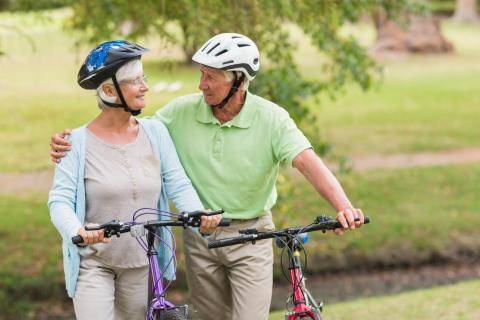10 Tips for Senior Cyclists
Still, safety is an issue to consider. With more older cyclists, the rate of bicycle-related injuries also is up in the senior population. Hospitals report seeing more older cyclists who have been hit by a car, gone over the handlebars on a rough patch of pavement, or suffered a “wear and tear” injury to a joint or muscle. Dr. Benjamin Breyer of the University of California San Francisco reported, “If you take typical 25-year-olds and 60-year-olds, if they have a similar crash, it’s likely the older person will have more severe injuries.”
Dr. Breyer urged communities to add more bike lanes and other bike-friendly infrastructure. “And all cyclists should be aware of the risks and take appropriate precautions such as using appropriate safety gear, including helmets, and they should follow the rules of the road,” he added.
Here are more tips from cycle safety experts:
- Always wear a properly fitted bike helmet.
- Select a bike that’s right for your abilities and health condition, and keep it in good repair.
- Check tires and brakes routinely.
- Avoid riding at night.
- Equip your bike with lights and other safety equipment.
- Wear bright-colored clothing with reflective stripes and patches for visibility.
- Try padded cycling shorts if you’re going for the distance.
- Select bike paths and roads that are in good condition and separate from automobile traffic if possible.
- Sign up for a bike safety class.
- Learn the traffic laws that apply to cyclists and follow them just as you would when driving:
- Obey stoplights, signs, signals and lane markings.
- Ride in the same direction as traffic.
- Stop at intersections before crossing the street.
- Be careful near parked vehicles where someone might open a car door.
- Watch for vehicles coming out of driveways.
- Yield to pedestrians; equip your bike with a bell or horn.
Talk to your healthcare provider before beginning any exercise program; ask about health conditions and medications that could affect your ability to operate a bicycle safely. Muscle and joint problems, vision loss and memory problems all could make you less safe on a bike. Ask your doctor about physical therapy for better body mechanics, exercise training, or other resources to improve your technique.
Now, then there’s only one question left: spandex biking shorts—yea or nay?
The information in this article is not intended to replace the advice of your doctor. Talk to your health care provider before beginning any exercise program.
